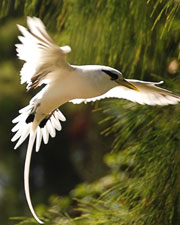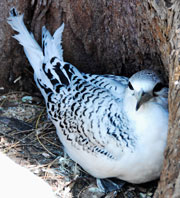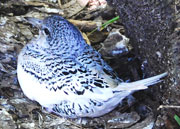Wingspan: 90-95 cm
Introduction
White-tailed Tropicbirds are a fairly widespread resident of Seychelles coastal waters and are often seen over hills inland too. They breed in large numbers on rat-free offshore islands, but are also known to nest in tall trees and inland cliffs on the main islands.

Identification
They are smaller in size than the Red-tailed Tropicbird and have a less bulky appearance, are more slim line, with shorter wings and more rapid wing-beats. Adults are very striking in appearance, with a black and white pattern on their upper wings and long thin white tail streamers. They are most commonly witnessed soaring high over the main islands, distinguishable from the much smaller fairy tern by their stiffly held wings, long tail and black upper wing patterning. Adults are mainly white with a distinctive black bar across their upper wing coverts and black bases on their wing tips. Although difficult to spot from a distance, their long white tail streamers have long black shafts. They have narrow black bar curves from their gape to their eye and have additional black markings on their thigh feathers. They have a large yellow bill and dark grey feet. Juveniles have a similar appearance to the adults, but lack the tail streamers. They have an abundance of blackish barrings on their crowns, napes, mantle and wing coverts. They also have a yellow bill, which normally has a darker tip.
Voice
White-tailed Tropicbirds have a harsh, high-pitched "kek, kek" call, that is most comply demonstrated at the nest and in aerial display.
Behaviour
They are most likely to be witnessed gliding high over islands, often in pairs. They are very tame and approachable at their nest sights on the ground. Adults do the majority of their feeding at night and chicks are usually fed in the morning. It is usual to see them resting and preening themselves on the sea surface.
Breeding
These birds breed throughout the year, with pairs being on the most part faithful to their partner and the nest site. They typically lay one single brick-red egg, which takes around six weeks to hatch. After a further twelve weeks, the chicks will fledge, which usually involved walking from the nest site to the sea.
Photographs kindly provided by Doug Howes
Praslin - La Digue - Aldabra - Bird Island - Mahe - Islands of the Sainte Anne Marine Park - Desroches & the Amirantes - Silhouette - North Island - Fregate - Cousine - Cousin - Aride - Denis - Alphonse - Felicite - Marianne - Victoria - Assumption - Cosmelido - Vallée de Mai - Coco de Mer - St Pierre - Seychelles Black Parrot - Seychelles Blue Pigeon - Seychelles Fruit Bat - Seychelles Paradise Flycatcher - Scops Owl - Giant Tortoise - Tailor Made Holiday in the Seychelles - Bareboat & Skippered Yacht Charters - Sailing Guide to Seychelles - Liveaboard Diving - Dive & Snorkel Holidays - Wildlife Natural History & Birdwatching - Beaches - beach vacations - Marine Life whales sharks rays dolphins & coral reefs - Hiking Trekking Car Rentals Hotels Resorts & Accommodation - Mountains & Rainforest - Responsible Travel - Honeymoons & weddings - Family Adventures - Single Travellers - Whale Shark Research & Conservation







